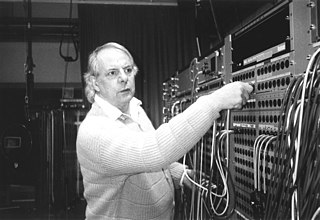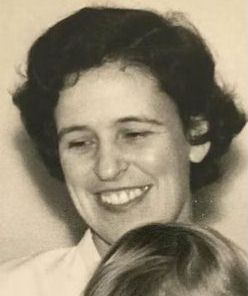Related Research Articles

Karlheinz Stockhausen was a German composer, widely acknowledged by critics as one of the most important but also controversial composers of the 20th and early 21st centuries. He is known for his groundbreaking work in electronic music, having been called the "father of electronic music", for introducing controlled chance into serial composition, and for musical spatialization.
Kontra-Punkte is a composition for ten instruments by Karlheinz Stockhausen which resolves contrasts among six instrumental timbres, as well as extremes of note values and dynamic levels, into a homogeneous ending texture. Stockhausen described it: "Counter-Points: a series of the most concealed and also the most conspicuous transformations and renewals—with no predictable end. The same thing is never heard twice. Yet there is a distinct feeling of never falling out of an unmistakable construction of the utmost homogeneity. An underlying force that holds things together—related proportions: a structure. Not the same Gestalten in a changing light. But rather this: various Gestalten in the same light, that permeates everything."

Momente (Moments) is a work by the German composer Karlheinz Stockhausen, written between 1962 and 1969, scored for solo soprano, four mixed choirs, and thirteen instrumentalists. A "cantata with radiophonic and theatrical overtones", it is described by the composer as "practically an opera of Mother Earth surrounded by her chicks". It was Stockhausen's first piece composed on principles of modular transposability, and his first musical form to be determined from categories of sensation or perception rather than by numerical units of musical terminology, which marks a significant change in the composer's musical approach from the abstract forms of the 1950s.

Aus den sieben Tagen is a collection of 15 text compositions by Karlheinz Stockhausen, composed in May 1968, in reaction to a personal crisis, and characterized as "Intuitive music"—music produced primarily from the intuition rather than the intellect of the performer(s). It is Work Number 26 in the composer's catalog of works.
Gruppen for three orchestras (1955–57) is amongst the best-known compositions of German composer Karlheinz Stockhausen, and is Work Number 6 in the composer's catalog of works. Gruppen is "a landmark in 20th-century music ... probably the first work of the post-war generation of composers in which technique and imagination combine on the highest level to produce an undisputable masterpiece".

Tierkreis (1974–75) is a musical composition by the German composer Karlheinz Stockhausen. The title is the German word for Zodiac, and the composition consists of twelve melodies, each representing one sign of the zodiac.

Montag aus Licht is an opera by Karlheinz Stockhausen in a greeting, three acts, and a farewell, and was the third of seven to be composed for the opera cycle Licht: die sieben Tage der Woche. The libretto was written by the composer.
Carré (Square) for four orchestras and four choirs (1959–60) is a composition by the German composer Karlheinz Stockhausen, and is Work Number 10 in the composer's catalog of works.

Zeitmaße is a chamber-music work for five woodwinds composed in 1955–1956 by German composer Karlheinz Stockhausen; it is Number 5 in the composer's catalog. It is the first of three wind quintets written by Stockhausen, followed by Adieu für Wolfgang Sebastian Meyer (1966) and the Rotary Wind Quintet (1997), but is scored with cor anglais instead of the usual French horn of the standard quintet. Its title refers to the different ways that musical time is treated in the composition.

Atmen gibt das Leben, is a choral opera with orchestra by Karlheinz Stockhausen, written in 1974 and expanded in 1976–77. It is Number 39 in the catalogue of the composer's works, and lasts about 50 minutes in performance.

Punkte (Points) is an orchestral composition by Karlheinz Stockhausen, given the work number ½ in his catalogue of works.
Formel (Formula) is a composition for chamber orchestra by Karlheinz Stockhausen, written while he was still a student in 1951. It is given the number 1⁄6 in his catalog of works, indicating that it is amongst the pieces preceding the composition he recognised as his first mature work, Nr. 1 Kontra-Punkte.

Stop is a composition for orchestra by Karlheinz Stockhausen, work-number 18 in the composer’s catalogue of works, where two performing realisations are also found as Nr. 18½ and Nr. 18⅔.
Schlagtrio is a chamber-music work for piano and two timpanists composed by Karlheinz Stockhausen in 1952. It is Nr. ⅓ in his catalogue of works.
A Garland for Dr. K. is a set of eleven short compositions created in 1969 for the celebration of the eightieth birthday of Dr Alfred Kalmus, the director of the London branch of Universal Edition. It is also the title of an album containing these eleven pieces of music, recorded in 1976.

The Sonatine (Sonatina) for violin and piano is a chamber music composition by Karlheinz Stockhausen, written while he was still a student in 1951. It carries the work-number ⅛ in his catalogue of works.
Spiel is a two-movement orchestral composition by Karlheinz Stockhausen, written in 1952. Withdrawn by the composer after its first performance, it was later revised and restored to his catalogue of works, where it bears the work-number ¼. The score is dedicated to the composer's first wife, Doris.
Chöre für Doris, after poems by Paul Verlaine, is a three-movement a cappella choral composition by Karlheinz Stockhausen, written in 1950 and later given the number 1/11 in the composer's catalogue of works. The score is dedicated to the composer's future wife Doris.
"Choral" (Chorale) is a short a cappella choral composition by Karlheinz Stockhausen, who wrote both the words and music in 1950. It was later given the number 1/9 in the composer's catalogue of works and lasts about four minutes in performance. The score is dedicated to the composer's first wife, Doris Stockhausen, née Andreae.

Doris Gertrud Johanna Stockhausen was the early muse and first wife of Karlheinz Stockhausen, who dedicated several compositions to her, beginning in 1950 with Chöre für Doris before they were married. After they separated she taught piano.
References
- ↑ Kurtz 1992, pp. 27, 31.
- ↑ Stockhausen 1978, p. 41.
- ↑ Kurtz 1992, p. 184.
- ↑ Frisius 2008, p. 25.
- ↑ Maconie 2005, p. 15.
- ↑ Kohl 2008.
- ↑ Maconie 2005, p. 36.
Cited sources
- Frisius, Rudolf. 2008. Karlheinz Stockhausen II: Die Werke 1950–1977; Gespräch mit Karlheinz Stockhausen, "Es geht aufwärts". Mainz, London, Berlin, Madrid, New York, Paris, Prague, Tokyo, Toronto: Schott Musik International. ISBN 978-3-7957-0249-6.
- Kohl, Jerome. 2008. "Drei Lieder (Three Songs) for Alto Voice and Chamber Orchestra". Programme book for the Klang Festival, (1–9 November), Southbank Centre, London, 20–21. London: Southbank Centre.
- Kurtz, Michael. 1992. Stockhausen: A Biography, translated by Richard Toop. London and Boston: Faber and Faber. ISBN 0-571-14323-7 (cloth); ISBN 0-571-17146-X (pbk).
- Maconie, Robin. 2005. Other Planets: The Music of Karlheinz Stockhausen. Lanham, Maryland, Toronto, Oxford: Scarecrow Press. ISBN 0-8108-5356-6.
- Stockhausen, Karlheinz. 1978. "Drei Lieder für Altstimme und Kammerorchester (1950)". In his Texte zur Musik 4 (1970–1977), edited by Christoph von Blumröder, 41–45. DuMont Dokumente. Cologne: DuMont Buchverlag. ISBN 3-7701-1078-1.